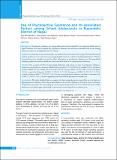Please use this identifier to cite or link to this item:
https://hdl.handle.net/20.500.14356/1140Full metadata record
| DC Field | Value | Language |
|---|---|---|
| dc.contributor.author | Bhandari, Tulsi Ram | - |
| dc.contributor.author | Paudel, Grish | - |
| dc.contributor.author | Bestman, Amy | - |
| dc.contributor.author | Thapa, Tarka Bahadur | - |
| dc.contributor.author | Gwayali, Chunna Prasad | - |
| dc.contributor.author | Ghimire, Bishnu | - |
| dc.contributor.author | Sharma, Shanta | - |
| dc.contributor.author | Yadav, Uday Narayan | - |
| dc.date.accessioned | 2023-04-27T08:57:12Z | - |
| dc.date.available | 2023-04-27T08:57:12Z | - |
| dc.date.issued | 2021 | - |
| dc.identifier.citation | BhandariT. R., PaudelG., BestmanA., ThapaT. B., GwayaliC. P., GhimireB., SharmaS., & YadavU. N. (2021). Use of Psychoactive Substance and its Associated Factors among School Adolescents in Rupandehi District of Nepal. Journal of Nepal Health Research Council, 19(03), 474-480. https://doi.org/10.33314/jnhrc.v19i3.3405 | en_US |
| dc.identifier.issn | Print ISSN: 1727-5482; Online ISSN: 1999-6217 | - |
| dc.identifier.uri | http://103.69.126.140:8080/handle/20.500.14356/1140 | - |
| dc.description | Original Article | en_US |
| dc.description.abstract | Abstract Background: Psychoactive substance use among adolescents has been identified as an important health issue in Nepal. Therefore, this study examined the psychoactive substance use and factors associated with its use among adolescent students in the Rupandehi district of Nepal. Methods: A school-based cross-sectional study was conducted from December 2017 to July 2018 with 460 school students aged between 15 to 19 years across sampled public and private schools in the Rupandehi district of Nepal. Structured interview schedule was used to collect information on psychoactive substance use. The generalized estimating equation was used to identify the factors associated with the use of psychoactive substances. Results: Over a quarter (27.4%) of school-going adolescents used at least one type of psychoactive substance. Commonly used psychoactive substance included tobacco products (59.3%) followed by cannabis (55.6%), marijuana (35.8%), hashish (23.5%), alcohol (22.2%), heroin (18.5%), nitrogen tablets (14.8%), sulfa (13.6%) and opium (13.6%), respectively. Being male (AOR=2.0, 95% CI: 1.19-3.36), having peers (AOR=1.8, 95% CI: 1.13-3.03) or family members (AOR=2.2, 95% CI: 1.40-3.54) that used psychoactive substances and father’s education level (AOR=2.5, 95% CI: 1.05-5.78) were significantly associated with the psychoactive substance use. Conclusions: This study identified that over a quarter of school-going adolescents reported the use of at least one illegal psychoactive substance. This study provided details on the extent of behaviours, and can be used to develop a comprehensive prevention and control program. Such programs should address the socio-cultural factors that enable substance use and address gaps in knowledge to prevent and control of psychoactive substance use. Keywords: Alcohol use; drug abuse; psychoactive substance use; tobacco use | en_US |
| dc.language.iso | en | en_US |
| dc.publisher | Nepal Health Research Council | en_US |
| dc.relation.ispartofseries | July-Sep, 2021;3405 | - |
| dc.subject | Alcohol use | en_US |
| dc.subject | drug abuse | en_US |
| dc.subject | psychoactive substance use | en_US |
| dc.subject | tobacco use | en_US |
| dc.title | Use of Psychoactive Substance and its Associated Factors among School Adolescents in Rupandehi District of Nepal | en_US |
| dc.type | Journal Article | en_US |
| local.journal.category | Original Article | - |
| Appears in Collections: | Vol. 19 No. 03 (2021): Vol 19 No 3 Issue 52 Jul-Sep 2021 | |
Files in This Item:
| File | Description | Size | Format | |
|---|---|---|---|---|
| 3405-Manuscript-25061-1-10-20211215.pdf | Fulltext Download | 221.83 kB | Adobe PDF |  View/Open |
Items in DSpace are protected by copyright, with all rights reserved, unless otherwise indicated.
